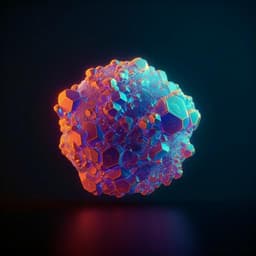
Engineering and Technology
High-concentration silver alloying and steep back-contact gallium grading enabling copper indium gallium selenide solar cell with 23.6% efficiency
J. Keller, K. Kiselman, et al.
Discover how researchers Jan Keller, Klara Kiselman, Olivier Donzel-Gargand, Natalia M. Martin, Melike Babucci, Olle Lundberg, Erik Wallin, Lars Stolt, and Marika Edoff achieved a groundbreaking efficiency of 23.64% for (Ag,Cu)(In,Ga)Se₂ solar cells through innovative strategies. Their work is paving the way towards achieving a remarkable 25% efficiency in the future!
~3 min • Beginner • English
Introduction
The study targets improving chalcopyrite-based thin-film solar cell efficiency beyond prior records by engineering absorber composition and profiles. Previous best efficiencies (~23.35%) were achieved with sulfur incorporation and heavy alkali post-deposition treatments. The authors propose that minimizing bandgap fluctuations and optimizing the bandgap magnitude, combined with high silver alloying in the absorber and a steep Ga gradient near the back contact, can reduce open-circuit voltage (Voc) losses and enhance overall performance. They implement a ‘hockey stick’-like GGI profile (constant Ga in upper absorber, steep increase near back contact), relatively high Ag alloying (AAC=0.19), and an RbF PDT to passivate the surface, aiming to reach and understand pathways toward 25% efficiency.
Literature Review
- Heavy alkali (K, Rb, Cs) incorporation into CIGS absorbers and interfaces raised efficiencies from ~20% to ~23% over the last decade. Ag alloying in CIGS (forming ACIGS) lowers melting temperature, enhances grain growth and reaction rates, reduces structural disorder, eases Ga/In interdiffusion, lowers band edge energies, and enables near-stoichiometric compositions without shunting.
- Solar Frontier achieved 23.35% efficiency in 2019 using sequential sulfurization after selenization with minimal Ag (<1 at.%), typically resulting in constant GGI in the upper absorber and increasing GGI toward the back contact, creating a beneficial back surface field. Surface sulfurization lowered the valence band maximum, increased Eg near the buffer, and reduced heterojunction recombination, boosting Voc.
- In co-evaporation processes without sulfur, a ‘notch’ GGI profile (lowest GGI near the SCR edge) is often used to reduce interface/SCR recombination; ZSW reached 22.6% in 2016 with such a profile using three-stage co-evaporation.
- State-of-the-art devices all employ heavy alkali PDTs; the highest efficiencies also include some Ag alloying. Literature comparisons show similar Jsc losses (~11–12%), relatively low FF losses (≤8% except for flexible low-temp devices), and that further gains are needed in both Jsc and Voc.
Methodology
Device fabrication: Stack soda lime glass/Mo/NaF-precursor/ACIGS/RbF-PDT/CdS/i-ZnO/ZnO:Al/MgF₂. A 290 nm Mo back contact was DC-sputtered, followed by thermal evaporation of a 10 nm NaF precursor (no alkali diffusion barrier). ACIGS (~2.0–2.1 µm) was deposited via a modified three-stage (I-poor → I-rich → I-poor) co-evaporation at ~530 °C with all elements supplied in all stages. Final absorber composition by XRF: GGI=0.28, AAC=0.19, [I]/[III]=0.84. Heavy alkali PDT: 3–5 nm RbF deposited at 350 °C in-vacuo without extra Se. A ~25 nm CdS buffer was grown by CBD at 60 °C. Window: 30 nm i-ZnO (RF sputter) and 230 nm ZnO:Al (DC sputter). Front contact: Al grid (~12 µm lines, ~1 mm pitch). Anti-reflection: 110 nm MgF₂. 27 cells of 1.03 cm² were defined by photolithography and selective etching; 22 cells exceeded 23% efficiency.
Electro-optical characterization: All JV/EQE measured after 24 h light soaking (no active cooling; ~50 °C). In-house JV on full 1.03 cm²; certified JV (Fraunhofer ISE) with 0.90 cm² aperture. One-diode fits to in-house JV extracted Rs, Rsh, J0, n. EQE with Bentham PVE 300 included grid shading. PL and ERE at ~1 sun using an integrating sphere; ERE computed from emission/scatter integration; maximum ERE 1.6% after 7 h light soaking.
Materials/structure characterization: SEM cross-sections and etched-surface imaging; TEM/STEM-EDS on FIB-prepared lamellae (final milling ≤2 kV); nano-XRF at MAX IV NanoMAX (16 keV, ~55×55 nm spot, 1,000 ms dwell) with PyMca analysis for elemental maps; GDOES for depth profiles over ~3 mm² area. Bandgap extracted from EQE first derivative (dEQE/dE or dEQE/dλ) and corroborated by PL; Urbach energy from EQE tail fitting.
Key Findings
- Certified device efficiency η=23.64% (in-house 23.75%) with parameters: Voc=767 mV (763 mV in-house), Jsc=38.3 (38.5) mA cm⁻², FF=80.5% (80.8%), n=1.30, Rs=0.33 Ω·cm², Rsh=7.8 kΩ·cm², J0=12 pA cm⁻².
- Bandgap and optical properties: Eg=1.130 eV from dEQE/dλ; PL peak suggests Eg=1.114 eV; Urbach energy EU=14.5 meV. Parasitic absorption losses estimated ~1.4 mA cm⁻² in CdS and ≥0.8 mA cm⁻² in i-ZnO/ZnO:Al; projected η≈25.0% if parasitic absorption eliminated. MgF₂ ARC reduced reflection <3% (550–850 nm).
- External radiative efficiency (ERE) reached 1.6% at 1 sun after ~7 h light soaking—among the highest directly measured for chalcopyrites—predicting Voc≈765 mV, in agreement with measured 767 mV.
- Device achieves ~72.0% of Shockley–Queisser limit at corresponding Eg, lower than SF 2019 (73.7%) but benefits from a higher Eg closer to the AM1.5G optimum (~1.15 eV).
- Absorber engineering: Implemented ‘hockey stick’ GGI profile—upper half with nearly constant Ga (minimized lateral and depth Eg fluctuations), steep GGI rise near back contact (GGI 0.65–0.80 at MoSe₂/ACIGS); high Ag alloying AAC=0.19. Large grains (>1 µm) observed; upper absorber shows small compositional variations and [I]/[III]≈0.83.
- RbF PDT effects: Rb agglomeration at both front (ACIGS/CdS) and back (ACIGS/MoSe₂) interfaces and selective GB decoration. Identification of Rb-rich patches under CdS (up to >50–100 nm laterally) and evidence for a thin (<5 nm) continuous Rb–In–Se layer likely RbInSe₂; surface depletion of Cu and Ga (locally Ag). Slight Cd in-diffusion (1–2 nm) into Rb–In–Se observed.
- Grain boundaries: Many GBs Cu-depleted and Ag-enriched; some GBs Ga-enriched and In-depleted; Rb decorates presumed random high-angle GBs; one GB showed no Rb. Triple junctions can show high Rb. A ~7 nm MoSe₂ interlayer is present at the back contact.
- Comparative analysis: Across leading (A)CIGS records, Jsc losses are similar (11–12%), FF losses small (≤8% except flexible), Voc deficit in this work ~12% vs. best SF ~11%; suggests further gains are available in both Voc and Jsc.
Discussion
The implemented absorber design directly addresses recombination and bandgap fluctuation losses limiting Voc. The ‘hockey stick’ GGI profile stabilizes Eg in the upper absorber and increases Ga near the back to create an electron-repelling field, reducing back-contact recombination and spatial bandgap variations. High Ag content (AAC=0.19) supports large grains, reduces structural disorder, and facilitates Ga/In interdiffusion, further mitigating fluctuations and aiding junction quality. The RbF PDT forms a passivating Rb–In–Se phase at the surface and decorates selected GBs and interfaces, evidently improving nonradiative recombination pathways as reflected in a high ERE (1.6%) and low ideality factor (n=1.30). Extensive light soaking increases Voc and FF, consistent with alkali-treated CIGS behavior.
Despite not exceeding the SF device in relative proximity to radiative limits, the higher bandgap closer to the AM1.5G optimum and minimized fluctuations enabled a new record efficiency. Remaining performance deficits predominantly arise from parasitic absorption in CdS and window layers and from residual nonradiative losses limiting Voc and n. The results highlight that optimizing Eg, suppressing bandgap/compositional fluctuations, and surface/GB passivation are synergistic in achieving high efficiency, while optical losses must be addressed to approach 25%.
Conclusion
A certified 23.6% efficient ACIGS solar cell is demonstrated by combining high silver alloying (AAC=0.19), a ‘hockey stick’ Ga profile (constant GGI in the upper absorber and steep increase near the back), and an RbF PDT that forms Rb–In–Se at the surface and decorates interfaces and selected GBs. The device shows large grains, minimized bandgap fluctuations at the junction, high ERE (1.6%), and strong electrical performance (Voc=767 mV, Jsc=38.3 mA cm⁻², FF=80.5%). Structural analyses indicate RbInSe₂ patches and an ultrathin Rb–In–Se surface layer (<5 nm), Rb at both interfaces, and characteristic GB chemistry.
Future work to reach and surpass 25% should prioritize eliminating parasitic absorption in buffer and window layers (e.g., higher-Eg buffers, optimized or alternative TCOs like In₂O₃:H), further boosting ERE to reduce the Voc deficit and ideality factor, and deepening understanding/control of GB and surface phases (composition, passivation) while maintaining optimal bandgap and grading profiles.
Limitations
- Limited statistical sampling in STEM-EDS and TEM analyses due to small lamella volumes; lateral variability may be underrepresented.
- Possible FIB-induced artifacts (e.g., Ag diffusion smear-out) and potential Cd in-diffusion during lamella preparation complicate precise interfacial composition assignments.
- Identification of Rb–In–Se as RbInSe₂ is inferential; coexistence with minor Cu, Ga, Ag cannot be excluded; the net effect of Rb–In–Se patches on device performance remains unclear.
- Na content in the ACIGS bulk was below GDOES detection; its distribution at interfaces/GBs is uncertain.
- Differences in GB chemistry compared to prior studies (e.g., Ag enrichment) are not fully explained; more statistics and advanced methods are needed to quantify GB recombination impact.
- Voc deficit remains ~12% relative to radiative limit; parasitic optical losses in CdS and TCO constrain Jsc, indicating non-optimized optics.
Related Publications
Explore these studies to deepen your understanding of the subject.







